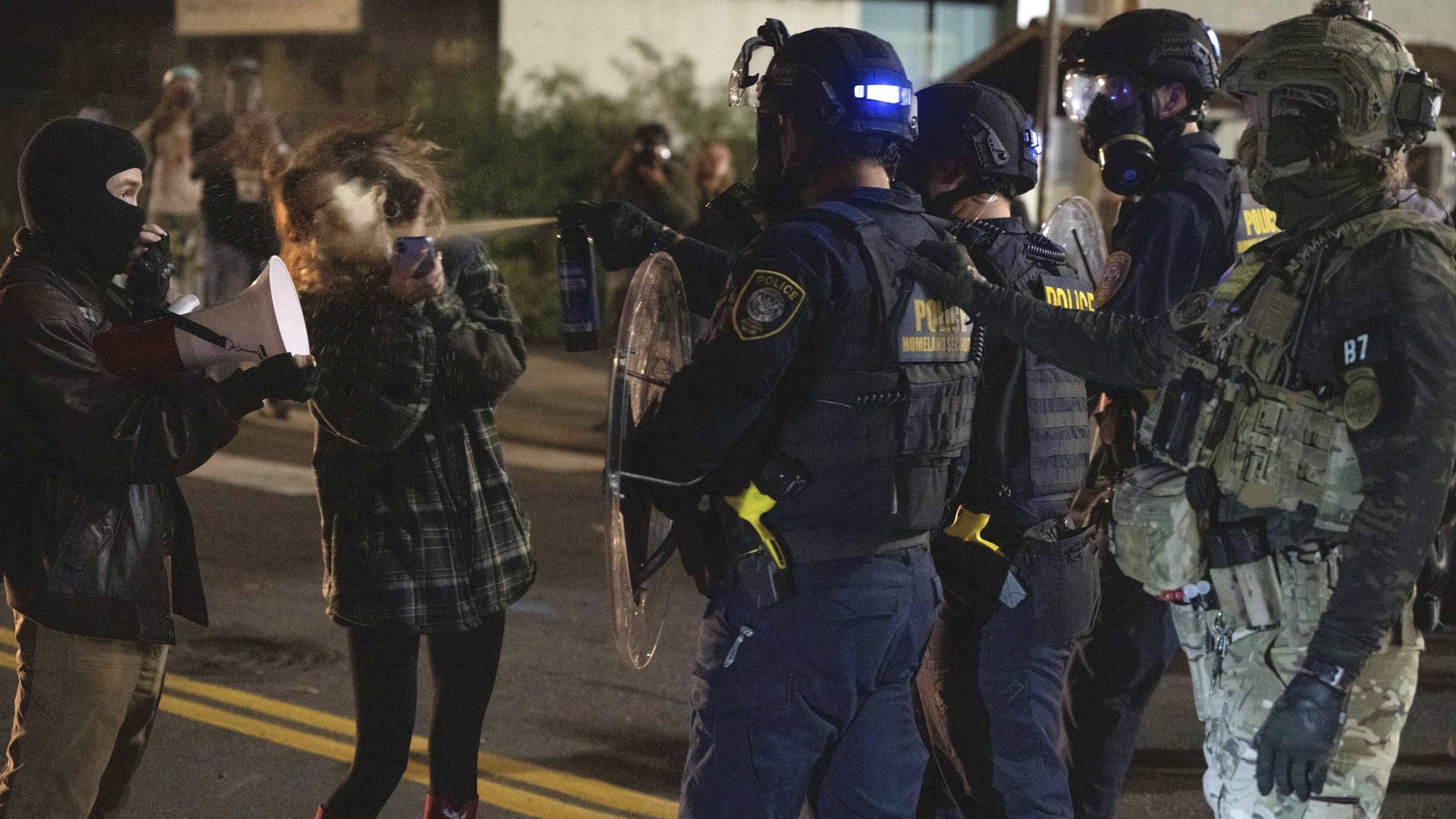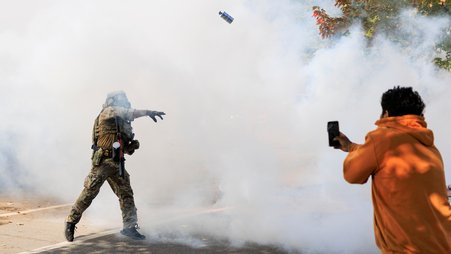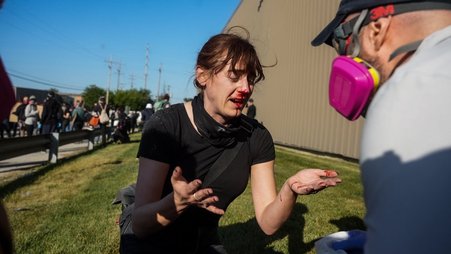You’ve probably seen the inflatable frogs, the dance parties, the naked bike ride. Maybe you’ve also seen the darker images: a federal officer aiming a weapon at protesters, or federal agents hurling tear gas and flash bangs into peaceful demonstrations at a Portland, Oregon, immigration facility.
Local journalists have been attacked for bringing images like these to the world. They’re being tear-gassed and shot with crowd-control munitions by federal agents simply for doing their jobs.
Photojournalist John Rudoff is among them. He’s been covering these protests since June, photographing both peaceful marches and violent responses from federal officers that often follow.
On Oct. 11, while documenting a protest, Rudoff was struck by a stinger grenade, even though he was clearly identifiable as press. He was bruised, but not deterred.
“If you cover protests, you’re going to have discomfort and hazard. Period. That’s just the way it is,” Rudoff told us. “They shoot 20-year-old girls, and they shoot 70-year-old men, and they shoot people in wheelchairs, and they shoot blind people,” he added, referring to federal agents using crowd-control munitions. “The word impunity seems to be coined for them.”
Despite the danger, Rudoff refuses to stop documenting. “The entire media ecosystem has been covered with the administration’s rantings about the war-ravaged hellscape of Portland, and the city is burning down, and ICE officers are being attacked, and on and on and on,” he said. “I feel some obligation to try and counter this frankly preposterous narrative that the city’s burning down. It isn’t.”
Independent journalist Kevin Foster, who has also been covering the Portland protests, shares that sense of duty and outrage. “It’s clear the Trump administration wants to paint Portland as a war zone to seize more control, but it’s a lot harder to do that when I’m showing you all the dancing inflatable frogs,” he told us. “At the end of the day, someone needs to be there to document abuses of power.”
Foster has felt the danger up close while reporting from protests. “I’ve seen other press members shot with pepper balls, I’ve had flash bangs go off at my feet, and tear gas canisters explode above my head,” he said. But he continues to work to keep the public informed, reporting on federal agents’ heavy use of force and escalatory tactics at the protests.
For Foster, the concerns go beyond federal agents at protests. “Right-wing influencers and agitators have reportedly doxxed people,” Foster said. “With the state of the presidency and the history of authoritarianism, I do sometimes worry about persecution as well, especially given that a lot of my coverage subverts the narrative produced by right-wing media.”
The incident in Portland that got the most attention involved Katie Daviscourt, a reporter for the conservative news site The Post Millennial. She reported being hit in the face by someone swinging a flagpole at a protest, blackening her eye. Police let the suspect go, prompting feigned outrage from the White House.
Holding federal agents accountable
Violence against the press, from any direction, is an attack on the First Amendment itself, especially when enabled by law enforcement. Unfortunately, those purportedly appalled by the Daviscourt incident have not shown similar concern over federal law enforcement attacks on journalists who don’t further their preferred political narratives.
Since the Portland protests began in June, for instance, photojournalist Mason Lake has been struck by crowd-control munitions twice, pepper-sprayed, and had a rifle aimed at him. Yet federal officials haven’t condemned these attacks, or the attack on Rudoff.
“It’s very disconcerting to see how free press has been trampled,” Lake told the U.S. Press Freedom Tracker, a project of Freedom of the Press Foundation (FPF). “The best we can do is push back and make sure the truth isn’t run over.”
In other cities, like Chicago, Illinois, and Los Angeles, California, federal court orders protect journalists from such assaults. But Portland currently has no such order. Legal precedent from 2020 protests in Portland recognized reporters’ First Amendment right to cover protests and shielded them from dispersal orders. But it has done little to rein in federal agents today.
“They have to be sued, and they have to be enjoined, and they have to be criminally prosecuted until they stop doing it,” suggested Rudoff.
Until that happens, however, journalists must keep speaking up, not just about what they see, but also for being attacked for witnessing it. “Most attacks on journalists aren’t reported,” explained Rudoff. But, he added, “I don’t know a single journalist out there who hasn’t been shot or hit or knocked over or tear-gassed or pepper-sprayed. It’s everybody.”
Foster put it even more bluntly: “Many Americans seem to have this impression that brutalizing protesters and targeting the press only happens in other countries. If that notion hasn’t shattered for you yet, wait until your ears are ringing from flash bangs and you’re enveloped in a cloud of tear gas so thick you can’t see 15 feet.”
This isn’t some distant dictatorship. It’s the city of Portland. And the First Amendment is under siege.





